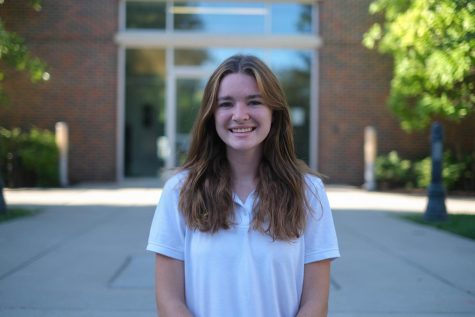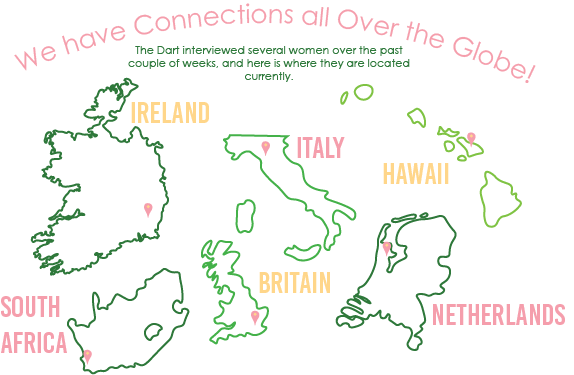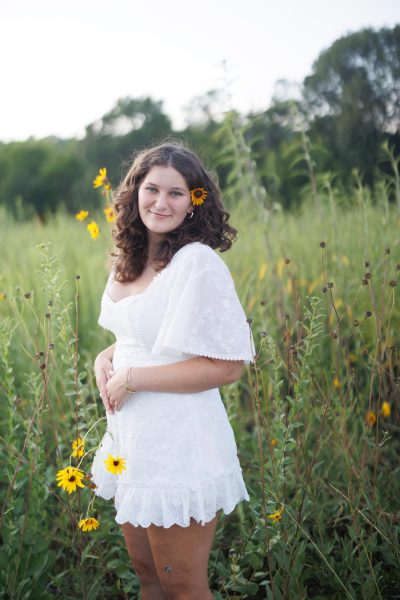Schooling Conundrum
Due to the COVID-19 pandemic, high schools are faced with a difficult conundrum. Do high schools send their kids to school every day, or is it safer to keep them at home?
Sophomore Stella Hughes fills out the daily health check-in form Jan. 28. All students must fill out the form each morning for attendance declaring if they will be on campus, absent or learning virtually. photo by Lucy Doerflinger
February 28, 2021
“When the whole school is in person it is a little scary — just like walking through the halls and stuff,” senior Tess Jones said.
St. Teresa’s has followed a matrix system during the 2020-2021 school year to determine which of these options they will choose for their students — in person, virtual or a hybrid model of learning. While the majority of the school followed this plan, certain students were on their own path, switching from virtual to in person throughout the semester and some with individually built hybrid plans. But because of the complicated nature of these individual plans, the rules surrounding them for the second semester of the 2020-2021 school year have changed.
At the beginning of the first semester, an email was sent out to parents with a section about immunocompromised students or students with any serious health issues asking them to contact nurse Angela Sweeney or principal for academic affairs Barb McCormick to talk about a learning plan. From there, administration composed individual virtual or hybrid learning plans for these students to accommodate their specific needs.
This semester, though, the administration decided there needed to be a change.
“Trying to create individual hybrid plans for all these different students and keep track of them and help teachers know when kids were on and off campus became a very overwhelming challenge,” McCormick said. “In order to keep attendance records straight, to ensure accountability for both teachers, students and parents, we felt the best decision was to move back to going face to face so you can choose that or a virtual option.”
Before the start of the second semester, another email was sent to parents of students who had followed a virtual or hybrid plan during the first semester. This email was to let them know of the rule changes and ask them once again to choose. Students had the choice to do either fully in person or fully virtual learning until spring break, and only then would they be allowed to reconsider, barring special circumstances.
The decision came down to a matter of over complicity.
“If you have a high number of students, which we had quite a few coming on different days of the week, who [were] filling out and making sure they did the COVID check-in form,” McCormick said. “Were they getting to class? Did the teacher even check them in that day? Could we contact trace that room? There were a lot of logistics to make sure that the environment and the accountability was upheld to the standard that we expected of ourselves, and we just felt like we could not continue at that level.”
Sophomore Emma Bridges has been virtual since the beginning of the school year because her 77 year old at-risk grandma lives with her. But now with everyone in her family expected to be vaccinated by early February, Bridges wonders what she’s missing out on due to the changes.
“If I had the choice to, I would have gone back the second my grandmother got the vaccine because my dad’s already been vaccinated, and my mom got her first round too, so then theoretically I was good to go back,” Bridges said.
Bridges also expressed that she completely understands the reasoning behind the decisions made for the safety of everyone at STA. She still wishes she could return to in person school since for her it’s been almost a year since she’s gone to school in person.
“I miss in person school for sure,” Bridges said. “I was pretty upset when my mom told me I had to stay home through spring break just because I kind of missed that interaction because I can’t go anywhere either because of my grandma, so not having that, school was the interaction that I was going to be able to have a little bit so just that was kind of upsetting.”
Despite this, Bridges believes the initially negative situation has been turned into a positive experience.
“Overall I think it’s been a positive experience,” Bridges said. “I’ve definitely had to grow up over the course of this semester, just because it was a new thing being one of the only virtual students, there’s not very many that are full time virtual. So I feel like for me and the teachers it was kind of a learning experience on what worked best, and for me I had to kind of change my habits a lot to be successful.”
Jones was sent home because of contact tracing in August, and that experience was a contributing factor as to why she chose in person school this semester.
“When half the class is online, half the class is in person and the teacher’s in person, they really do focus on the in person people more than the online,” Jones said.
Math teacher Dave Mitchell agrees that teaching a mix of in person and virtual students has been difficult.
“I think I know, I don’t give the virtual students the attention they need, because my focus is really on the people that are in my classroom,” Mitchell said. “I know they’re there, but it’s just not the same. They’re not getting the same experience as the in person people, for sure.”
Mitchell had an experience of many of his students being quarantined in August 2020 as well, and he says teaching during that time was difficult.
“Being new here and just not fully knowing how things should have worked even normally, I really struggled with that at the start, having people at home and people on campus and not knowing when people are going to be coming back on campus,” Mitchell said.
Mitchell said that another challenge to manage from a teacher’s standpoint was having virtual students take tests from home.
“You just have to really trust that students are going to be as honest as you’d like them to be,” Mitchell said.
Both Bridges and Jones agreed that if it were up to them, they prefer a hybrid option of learning best. For Bridges, it was about balance.
“I think I would do hybrid, just because it’s a good balance of both in person and virtual,” Bridges said.
For Jones, the decision was about getting ready for college next year.
“I think that [hybrid] was my favorite way we did it just because for me going to college next year, I felt like I was a college student because I had to be on top of my own things,” Jones said. “I would only go to class on certain days which is how it is in college, so I was able to get a good feel of what college is gonna be like, and if my grades slip that’s on me because I should be able to do it.”
As of Feb 5, Bridges was able to make the transition back to in person learning. After expressing some struggles she was having with the material in one of her classes, Bridges was allowed to return back to school to ensure her success in that class.
Even amidst COVID-19 restrictions, McCormick believes STA still had a successful first semester.
“If there’s anything we need to learn it’s to be adaptable, flexible, compassionate, patient and understanding,” McCormick said.










